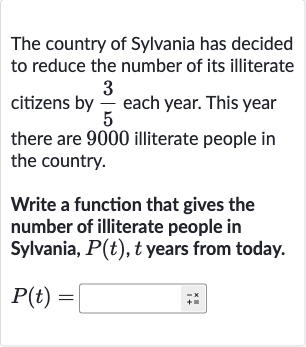AI tutor
Full solution
Q. The country of Sylvania has decided to reduce the number of its illiterate citizens by each year. This year there are illiterate people in the country.Write a function that gives the number of illiterate people in Sylvania, , years from today.
- Understand Reduction Fraction: Step : To model the reduction in the number of illiterate people, we need to understand that reducing the population by means that each year, of the population remains. This is because .
- Initial Population Value: Step : The initial number of illiterate people is given as . This will be our starting value for the function .
- Calculate Annual Multiplier: Step : Since the population is reduced by each year, the remaining fraction, , will be our annual multiplier. This means that each year, the population is multiplied by to find the new number of illiterate people.
- Write Function P(t): Step : We can now write the function that models the number of illiterate people after years. The function will have the form . Substituting the given values, we get .
- Check Function for Accuracy: Step : To check if the function is correct, we can consider what happens after year. should be , which is the expected number of illiterate people after a reduction of .
More problems from Interpret the exponential function word problem
QuestionGet tutor help
QuestionGet tutor help
QuestionGet tutor help
QuestionGet tutor help
QuestionGet tutor help
QuestionGet tutor help
QuestionGet tutor help
QuestionGet tutor help
QuestionGet tutor help

